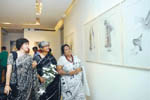Artist reminds people of catastrophes in apparel sector
 It is easier and comfortable if one can forget the sad things that happen to oneself or to one’s community and country. Most of us, in fact learn to forget quite comfortably. The forgetting part is usually made easy by our hectic routine life. But for an artist, it seems, that the process of forgetting is not what he/she wishes to do. When the collective consciousness tries to push certain memories or images to the back of mind, artists try to bring them to the foreground; thus begins the process of recollecting.
It is easier and comfortable if one can forget the sad things that happen to oneself or to one’s community and country. Most of us, in fact learn to forget quite comfortably. The forgetting part is usually made easy by our hectic routine life. But for an artist, it seems, that the process of forgetting is not what he/she wishes to do. When the collective consciousness tries to push certain memories or images to the back of mind, artists try to bring them to the foreground; thus begins the process of recollecting.
The ongoing solo exhibition of cross-genre artworks by Dilara Begum Jolly at Bengal Art Lounge at Gulshan testifies the artist’s endeavour to provoke our thoughts by invoking what seems to be washed away, or washing away slowly, from the collective consciousness.
Titled Threads of Testimony, Dilara has tried to connect a number of threads and themes so as to let us keep in mind what happened, what we must not forget. Dilara’s field of focus is the apparel sector, to be more specific, the humiliation and injustice of women and men in the garment sector which earns the country the highest foreign currency.
Not only are the catastrophes of Tazreen and Rana Plaza morphed into the artworks, but a generalisation of the workers’ condition is also present in Jolly’s works.
To take the works on the catastrophes, there is a series titled Object. Done mostly in resin, Dilara has recreated everyday objects like sandals, comb, plates to call up what is absent, that is, the users of these objects. Indeed, as Sajjad Sharif writes, Dilara has played with the dialect of presence and absence. In her works, presence of something refers to the absence of something too.
This dialect of presence and absence is also prominent in the installations where Dilara has covered objects like pillow, bed or dining table with xeroxed papers that read Missing with a photo and address of the person who’s missing. Such posters, if we recall, were carried by the relatives of the deceased at the site of Tazreen and Rana Plaza.
Some of these papers even do not have a photo of the person sought. Dilara seems to have wondered and questioned whether these photo-less individuals are entirely wiped out.
Besides the Object series, there are two powerful video installations of very short length that address the tragedy of Tazreen and Rana Plaza. The one on Tazreen is titled Tazreennama which is artistically stimulating and a bit eerie too. Dilara’s response is not like a reporter’s, who reports the number of casualities; rather she has tried to make us feel what it is to be burnt alive. A figure, allegedly female, is seen caught by fire. Her movements may mislead one to think it as a fiery flower, but the backdrop chorus of cries smash any illusion.
Another powerful series on display at the exhibition is titled Bayana, which, in a minimal twist may mean two things, stitching and narratives. Dilara, it appears, has tried to suggest both the meanings. She has come to share the neglected narratives of apparel workers. The series comprises mostly of drawings done in pen and ink, sometimes with small stitches as well.
The ingenuity of the series lies perhaps in the connection Dilara makes between spools of threads and the human body. Many of the drawings give the impression that the threads come out of a human body, which, in a strong metaphorical sense, is very true to the condition of apparel workers of our country.
As a whole, the artworks of Threads of Testimony generate more cerebral than emotional response, to quote Sajjad Sharif again. Inaugurated on August 16, the exhibition will remain open for all from 12pm to 8pm till September 4.
-With New Age input




















